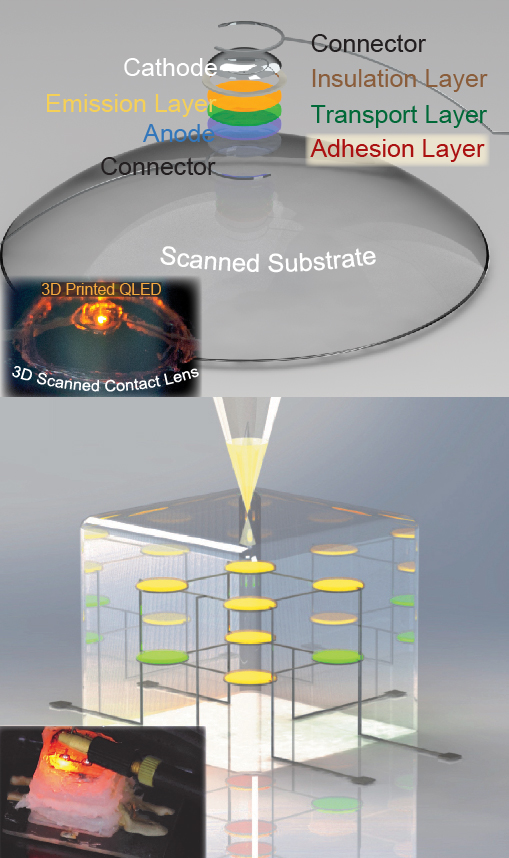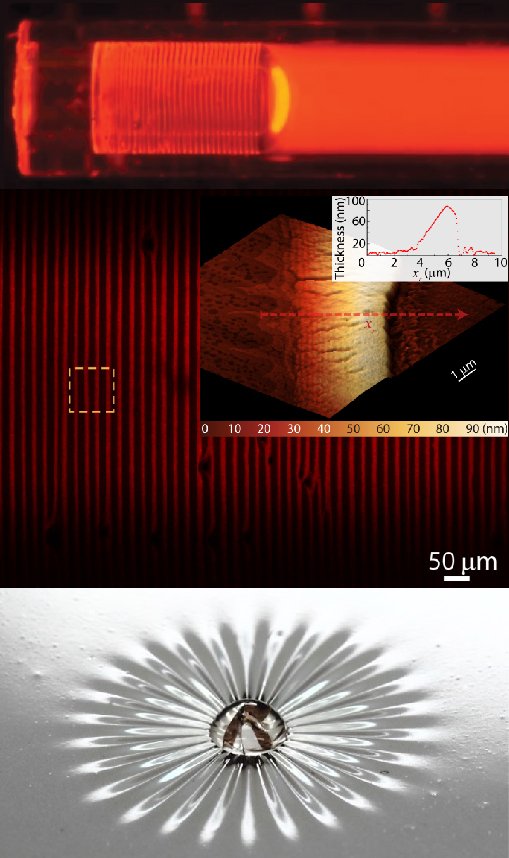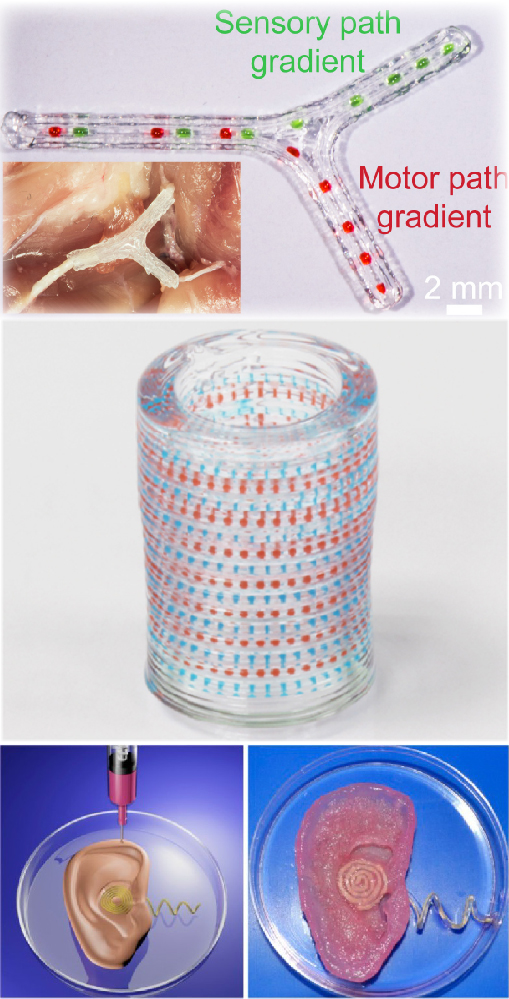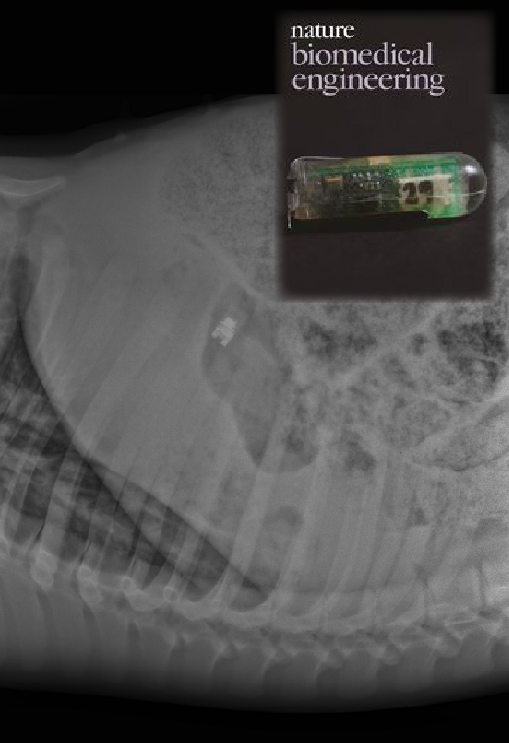Multi-scale 3D Printing of Active Electronics and Devices

Developing the ability to 3D print various classes of materials possessing distinct properties could enable the freeform generation of active electronics in unique functional, interwoven architectures. Achieving seamless integration of diverse materials with 3D printing is a significant challenge which requires overcoming discrepancies in material properties in addition to ensuring that all the materials are compatible with the 3D printing process. Indeed, to date, 3D printing has been limited to specific plastics, passive conductors, and a few biological materials. Here we are developing a multi-scale extrusion-based 3D printing approach that enables the integration of a diverse classes of materials to create a variety of 3D printed electronics and functional devices with active properties that are not easily achieved using standard microfabrication techniques.
- "3D Printed Active Electronic Materials and Devices." U.S. Patent 9,887,356 (issued February 6, 2018).
- "Addressing Unmet Clinical Needs with 3D Printing Technologies." Advanced Healthcare Materials 1800417 (2018).
- Top 10% most downloaded paper of the journal (2018 - 2019).
- "3D Printed Bionic Nanodevices." Nano Today 11, 330-350 (2016).
- "3D Printed Quantum Dot Light-Emitting Diodes." Nano Letters 14, 7017-7023 (2014).
- Featured in "Device fabrication: Three-dimensional printed electronics." Nature 518, 42-43 (2015).
- Highlighted in "Materials: Diodes printed in three dimensions." Nature 515, 468 (2014).
Complex Fluids & Soft Matter Physics for Multi-scale Functional Device Printing

Developing the ability to govern the assemblies of functional nanomaterials and polymers can impart an otherwise passive three-dimensional constructs with active functionalities. We study complex fluids mechanism and soft matter physics phenomenon to govern a variety of complex deposition process to achieve multi-scale functional device printing at a variety of constructs. For instance, micro-scale printing of nanomaterials can be achieved with directed or self-assembly based methods to generate a functional architecture without the need of conventional fabrication processes that are typically incompatible with a three-dimensional construct. The understanding of the mechanism of the deposition process, such as the evaporation kinetics, colloidal drying and assemblies phenomena could enable the creation of functional meso-scale architecture on or inside a variety of three-dimensional constructs that cannot be fabricated otherwise. Ultimately, the synergistic integration of the micro-scale assemblies of functional materials with advanced manufacturing technologies could realize the creation of unique functional devices.
- "Deposition of Quantum Dots in a Capillary Tube." Langmuir 31, 12560-12566 (2015).
- "Effect of the Polydispersity of a Colloidal Drop on the Drying Induced Stress as Measured by the Buckling of a Floating Sheet." Physical Review Letters 116, 238001 (2016).
- "A Scalable Platform for Functional Nanomaterials via Bubble‐Bursting." Advanced Materials 28, 4047-4052 (2016).
Multi-materials 3D printing of Hybrid Bio-electronics Medical Devices

The synergistic integration of biological systems with electronic materials and devices could enable the creation of novel bio-electronics medical devices that could potentially be utilized to restore or even augment the complex functionalities of naturally evolved biological systems. Yet, at the fundamental level, there are inherent materials compatibility challenges associated with integrating functional electronic materials with biology. Extrusion-based 3D printing is capable of incorporating a wide range of materials with disparate properties. This versatility has enabled the accommodation of different classes of materials encompassing a wide range of length-scales: including nanomaterials, fibers, cells, tissues, organs, ceramics, metals and polymers such as elastomers, gels, and biomaterials. We strive to overcome such dichotomies by developing multi-materials 3D printing technologies that can seamlessly integrate functional electronics with biological constructs to create unique biomedical devices that can address unmet clinical needs.
- "Multi-Functional Hybrid Devices/Structures Using 3D Printing." U.S. Patent 9,517,128 (issued December 13, 2016).
- "Addressing Unmet Clinical Needs with 3D Printing Technologies" Advanced Healthcare Materials 1800417 (2018).
- Top 10% most downloaded paper of the journal (2018-2019).
- "3D Printed Bionic Nanodevices." Nano Today 11, 330-350 (2016).
- "3D Printed Nervous System on a Chip." Lab on a Chip 16, 1393-1400 (2016).
- "3D Printed Anatomical Nerve Regeneration Pathways." Advanced Functional Materials 25, 6205-6217 (2015).
- "3D Printed Programmable Release Capsules." Nano Letters 15, 5321-5329 (2015).
- "3D Printed Bionic Ears." Nano Letters 13, 2634-2639 (2013).
- Highlighted in "The Cyborg Era Begins." Science 340, 1162-1165 (2013).
- Highlighted in “Bioelectronics: An Ear by Printing." Nature 499, 129 (2013).
- Highlighted in "Bioelectronics: Printing Bionic Ears." Nature Nanotechnology 8, 390 (2013).
3D Printing of Ingestible Wireless Biomedical Electronics

We are developing wireless ingestible biomedical electronics platform as the next generation remote monitoring, diagnosis and treatment platform. The surgical-free biomedical electronics integration with the human body can revolutionize telemedicine by enabling a real-time diagnosis and delivery of therapeutic agents. Towards this aim, we create functional materials, design unique architectures and develop a hybrid fabrication approach to enable the creation of highly-functional and safe ingestible biomedical electronics.
- "Ingestible Transiently Anchoring Electronics for Microstimulation and Conductive Signaling." Science Advances 6, no. 35, eaaz0127 (2020).
- "3D Printed Gastric Resident Electronics." Advanced Materials Technologies 1800490 (2018).
- Selected as one of the Best of Advanced Materials Technologies 2019.
- "Prolonged Energy Harvesting for Ingestible Devices." Nature Biomedical Engineering 1, 0022 (2017).
- Featured in "Bioelectronic devices: Gut-powered ingestible biosensors." Nature Biomedical Engineering 1, 0050 (2017).
- "Ingestible Power Harvesting Device, and Related Applications." U.S. Patent Application 15/498,268.
